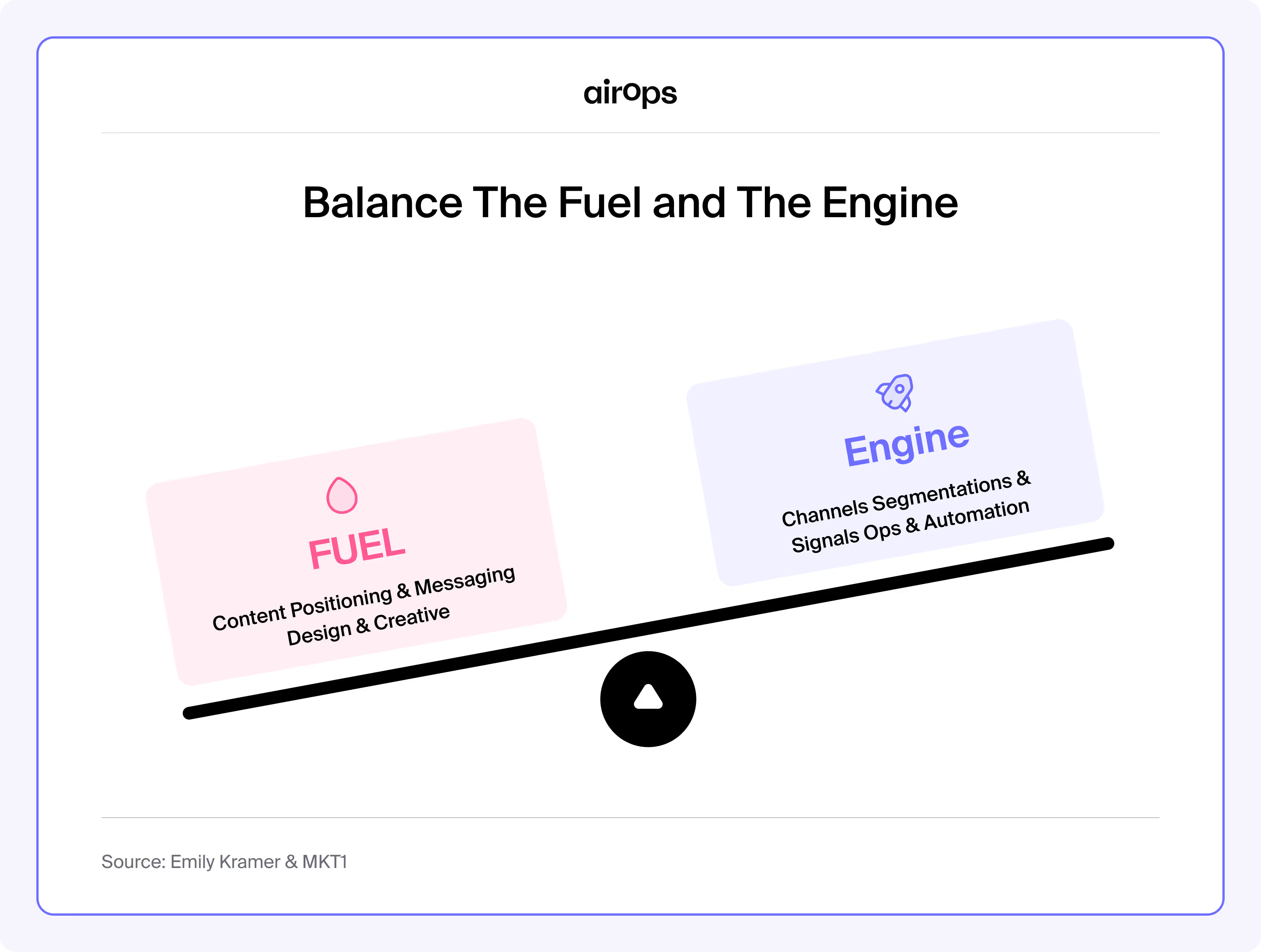CMO Series Webinar Recap: Why the Smartest CMOs Build Content Like a Product (With Emily Kramer)
.avif)
In our latest Growth Leader Series webinar, Emily Kramer (founder of MKT1, former marketing leader at Asana, Carta, and more) joined Josh Spilker from AirOps to share how leading CMOs can treat content as a product and a real value add to pipeline.
Top Takeaways
1. Think of Content as a Product, Not a Checkbox. Your content should solve real audience problems, and you should build it with the same rigor as product development.
2. Avoid Random Acts of Marketing. Focus on Big Bets. Strategic, theme-driven campaigns outperform scattered, quantity-focused content efforts every time.
3. Balance Fuel (Content) and Engine (Distribution) for Impact. Even the best content falls flat without a clear, distribution plan mapped to your audience.
4. Anchor Content Strategy in Unique Marketing Advantages and Perceptions. Lean into your company’s unique strengths and core narratives to guide content creation and stand out.
Best Practices and Key Learnings
To put these strategies into action, CMOs and content leaders should focus on systematic planning, campaign-driven execution, and meaningful measurement.
Build Content Like a Product
Emily Kramer outlined why leading CMOs treat content as a product, emphasizing a systematic, audience-driven approach instead of a quantity-focused mindset.
- Content must address real audience problems, mirroring the rigor of product development.
- Product-driven content strategies yield compounding value over time.
- Apply product management principles: roadmaps, audience research, and iterative improvement.
"Content is another product for your audience...you need to do the same thing with content." — Emily Kramer
Fuel vs. Engine: Content Powers the Whole GTM Motion
This is a mindset shift for CMOs. Content is not just for brand or SEO, it’s the connective tissue between marketing, product, and sales. When structured correctly, content becomes the bridge from awareness to revenue.
- Content without distribution is wasted; distribution without valuable content is ineffective.
- Always plan distribution before creating content.
- Start from first principles and company-specific strengths, not competitor copycatting.
- Identify your unique marketing advantages and double down on them.
"Don't do random acts of marketing...think about your big bets and what's going to drive impact." — Emily Kramer

Content is IP, Not Just Output
Emily’s core principle is simple: content should be unique and reusable with clear differentiators. That means treating your content library like a product roadmap.
The best content assets aren’t blog posts for blog posts’ sake. They are proprietary data reports, frameworks, expert takes, and unique points of view that your audience can’t find anywhere else. These are the kinds of assets that earn AI search mentions, citations, drive pipeline, and get shared by both humans and agents.
GACCS™: A Strategic Filter for CMOs
Before creating any piece of content, Emily recommends applying the GACCS™ framework:
- Goals – What outcome are you driving (influence, conversion, visibility)?
- Audience – Who is this for? What specific job are they trying to do?
- Creative – What is the unique angle or asset type?
- Channels – How will it be distributed, reused, or extended?
- Stakeholders - Who is involved
This isn't just a tool for content marketers. It's a filter CMOs can use to ensure every content investment is strategically aligned and competitively differentiated.
- This ensures content ladders up to strategy and has a clear distribution plan.
- Anchor content planning in clear perceptions and marketing advantages.
- Content should reinforce core narratives and frameworks for compounding value.
The 30% Juice Rule: Don’t Overdo Product Content
CMOs often default to content that revolves too closely around their product — but Emily warns against this.
.png)
She calls this the “30% juice rule,” inspired by a juice company that focused only 10% of its content on its actual product. For B2B startups, a better balance is 30% product-focused content (“juice”) and 70% problem-solving, educational, or tactical content that addresses your audience’s broader challenges.
This kind of content mix builds trust and visibility at the top and middle of the funnel, far before a prospect is ready to buy.
What This Means for Brand Visibility and Pipeline
Emily’s approach is built for modern visibility. By focusing on differentiated content, reusable assets, and audience-first strategy, she ensures your content doesn’t just get published — it gets seen, cited, and trusted.
- Problem-first content aligns with how buyers actually search and learn
- Proprietary frameworks and data build authority and influence
- Systematic repurposing keeps your brand visible across every stage and surface
Content built this way shows up in the right conversations, across the right channels, at the exact moments buyers are making decisions.
Win AI Search. Turn Visibility Into Action in One Platform.
AI search is rewriting the rules of organic growth. If you’re not showing up in ChatGPT, Google AI Mode, and Perplexity, you’re invisible. AirOps is the only all-in-one platform build to win AI search.
We show you exactly where your brand stands, where competitors are beating you, and what to do about it. Then we help you take action by refining existing content, creating net new, and engaging in social conversations.
Book a demo to join the AirOps Visibility → Actions early access.
Win AI Search.
Increase brand visibility across AI search and Google with the only platform taking you from insights to action.
Get the latest on AI content & marketing
Get the latest in growth and AI workflows delivered to your inbox each week
.avif)




